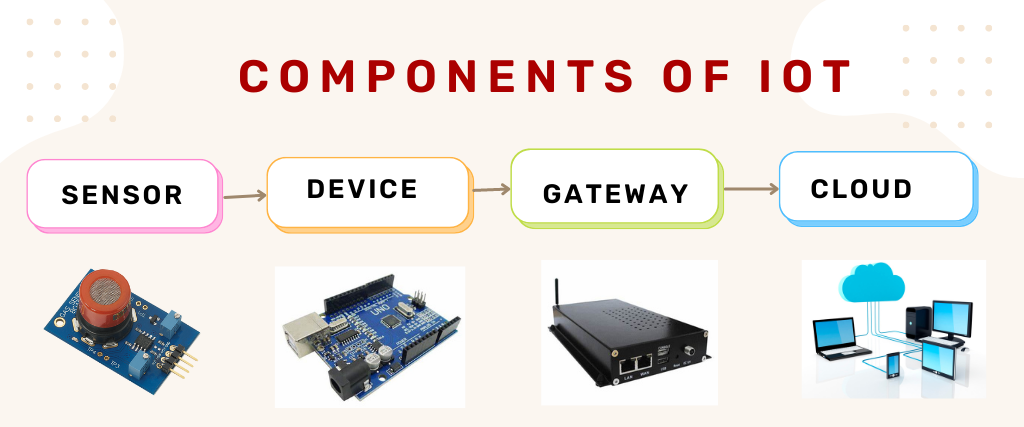IoT Architecture
The Internet of Things is transforming industry landscapes on a grand scale, thanks to increased internet service availability and low cost of hardware. IoT applications range from the medical field to construction, education, insurance, and a variety of other fields. The operation of an IoT system is defined by four key components. The diagram below depicts the components of an IoT System.

1. Sensor: Sensors or receivers are essential components for collecting real-time data from your surroundings. All of this data could be of varying complexity. It could be a simple temperature monitoring sensor or a video stream. A device may include a number of sensors that perform functions other than sense. A smartphone, for example, contains various sensors such as GPS and a camera, but these cannot be detected.
Most modern smart devices and sensors can communicate with low-power wireless networks like Wi-Fi, ZigBee, Bluetooth, Z-wave, LoRA WAN, and others. Each of these wireless technologies has advantages and disadvantages in terms of power, data transfer rate, and overall efficiency.
2. Devices: Devices are user interfaces that are a visible, tangible part of the IoT system that users can access. Designers must ensure a well-designed user interface to reduce user effort and encourage more interactions. The information must be made available to the end user in some way, which can be accomplished by setting alarms on their phones or sending notifications via email or text message. The user may require an interface that actively checks their IoT system from time to time. For example, suppose a user has a camera installed in his home and wishes to access video recordings and all feeds via a web server.
Modern technology allows for much more interactive design in order to simplify complex tasks into simple touch panel controls. Multicolor touch panels have largely replaced hard switches in our household appliances, and this trend is expected to continue for nearly every smart home device.
In today's competitive market, user interface design is increasingly important; it frequently determines whether a user chooses a particular device or appliance. Users will be interested in purchasing new devices or smart gadgets if they are easy to use and compatible with common wireless standards.
3. Gateway: As sensors and actuators produce large amounts of data, they need high-speed Gateways and Networks. This network can be a LAN, WAN, or MAN (WAN such as GSM, 5G, etc.). IoT Gateway manages bidirectional network data traffic. Gateways also translate network protocols to ensure device and sensor interoperability. Gateways can preprocess data from thousands of sensors before sending it on. TCP/IP compatibility may require it in some cases. Each option trades power, range, and bandwidth. Connectivity options depend on the IoT application, but they all send data to the cloud. IoT gateways offer network and data encryption for security. It protects the system from malicious attacks and unauthorized access.
4. Cloud: IoT data from devices, apps, and users must be efficiently managed. The Internet of Things cloud collects, processes, manages, and stores data in real-time. These data can be accessed remotely by industries and services, allowing them to make critical decisions. Data is transferred to the cloud. Sensors, devices and apps communicate with the cloud in a variety of ways. Mobile or satellite networks, Bluetooth, WI-FI, WAN, and other technologies
The Internet of Things cloud is a high-performance network of servers designed for quick data processing, traffic management, and accurate analytics. The Internet of Things cloud employs distributed database management systems. Cloud systems connect billions of devices, sensors, gateways, protocols, and data storage devices. Analytics data is used by businesses to improve products and services, take preventive measures, and build their new business model.
Once the data has been collected and transferred to the cloud, the software processes it. This process can be as simple as checking the temperature or reading on devices such as air conditioners or heaters. However, it can be very complex at times, such as identifying objects, using computer vision on video, or analyzing user preferences.